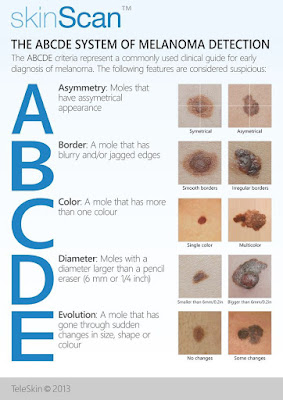Melanoma 101: Sunscreen and Self Checks
Melanoma 101:
Sunscreen and Self Checks
When a doctor tells their patient that sunscreen prevents
cancer, no one uses sunscreen. But, when the doctor tells their patient that
sunscreen prevents wrinkles, people use it habitually. More often when
physicians exercise the persons vanity, they change their habits. The fact of
the matter is, sunblock really does prevent melanoma. And when people also
check for moles and get them checked early, people live a higher quality of
life than those who don’t.
Sunscreen has been shown to have a dramatic reduction in
mortality due to melanoma. For example, in Australia, daily use of sunscreen
resulted in fourteen percent fewer diagnoses of melanoma in 2008 that would
have occurred otherwise. (Darlene Strayer) When
it comes to cancer, the less lives damaged, families torn, and lives lost the
better. When shopping for a sunscreen product it can be a little difficult to
know the right product, which will reduce the risk for melanoma. As anyone who
has bought sunblock before, knows not all sunblock is the same. Besides all the
different brands that are available, there are seemingly random numbers in bold
above the acronym SPF. SPF is ratio between how long it would take unprotected
skin to burn and the amount of time a sunscreen would additionally protect skin
before sunburn occurs. As imagined, a higher SPF means protection for longer
than a lower SPF. But, SPF protection does not increase proportionality with
the SPF number. A SPF of two would absorb fifty percent of UVB rays, while a
SPF of fifteen percent absorbs ninety-two percent of UVB rays and a SPF rating
of thirty-four absorbs ninety-seven percent of UVB radiation. While SPF
notifies of the UVB protection, it means nothing for UVA radiation that also
causes melanoma. To make sure UVA protection is also in sunscreen make sure it
says “broad-spectrum”. (Darlene Strayer) Lastly follow the
directions on the bottle; if the sunscreen needs to be reapplied after two
hours of use, reapply. Often sunscreen wears off leaving the body exposed to
the sun’s radiation.
Works Cited
Control, Center for Disease. What Are the Symptoms
of Skin Cancer? 26 April 2017.
https://www.cdc.gov/cancer/skin/basic_info/symptoms.htm. 25 Febuary 2018.
Darlene Strayer, Eliza Schub. Melanoma: Sunscreen
Use. Evidance-Based Care Sheet. California: Cinahl Infomation Systems,
2017. Document.



Comments
Post a Comment